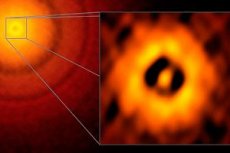New publications
ESO astronomers have managed to take new images of the Sun's surface
Last reviewed: 02.07.2025

All iLive content is medically reviewed or fact checked to ensure as much factual accuracy as possible.
We have strict sourcing guidelines and only link to reputable media sites, academic research institutions and, whenever possible, medically peer reviewed studies. Note that the numbers in parentheses ([1], [2], etc.) are clickable links to these studies.
If you feel that any of our content is inaccurate, out-of-date, or otherwise questionable, please select it and press Ctrl + Enter.

Scientists have obtained new images using the ALMA telescope, which has allowed them to discover new interesting details that had previously been impossible to see.
One important element in the images was a sunspot, the size of which is twice the diameter of planet Earth. The specialists were able to examine its structure in detail.
The new photographs are the first of their kind and greatly expand the capabilities of science at the moment. The telescope's detectors were designed in advance to minimize the possibility of damage from heat rays when viewing the Sun.
Astronomers used the telescope's giant array antenna to record the smallest possible range of the emitted spectrum of the solar chromosphere, a zone located in close proximity to the photosphere that forms the solar surface visible to us.
A group of international experts representing European countries, the United States and East Asia pointed out the enormous potential of the new telescope in the field of solar activity research at long wavelengths, which was previously impossible. Ground-based research observatories could only determine solar activity at short wavelengths.
For hundreds of years, scientists have tried to learn as much as possible about the Earth's "luminary", studying any visible changes on its surface. However, to sufficiently understand the physical characteristics of the Sun, it is necessary to examine it along the entire length of electromagnetic radiation, including the millimeter and submillimeter range. Such studies have become possible for the new ALMA telescope.
ALMA's detectors can create detailed images of the solar surface using radio interferometry without being damaged by the high temperatures of focused solar radiation. As a result, scientists have obtained a number of very important images for science, which will be released soon for further study and review.
The main object of study in this case was a large sunspot, studied in two frequencies of the ALMA detectors. The resulting photographs allowed us to record temperature differences in different parts of the Sun's chromosphere.
As a rule, sunspots are temporary elements that form in areas of increased concentration and growth of the magnetic field. The temperature in them is slightly lower than around the spots, which is why the illusion of a "spot" actually occurs.
The resulting images clearly show differences in temperature, which has raised many new questions for scientists.
The ALMA telescope is the first observatory of the European Space Research Organization that can fully conduct solar surface research. Any other instruments that have been used before or are currently in use require serious improvements in the area of protection against thermal damage that occurs due to overheating.
With ALMA's new capabilities, the Space Research Organization will be able to make progress in solar research.
